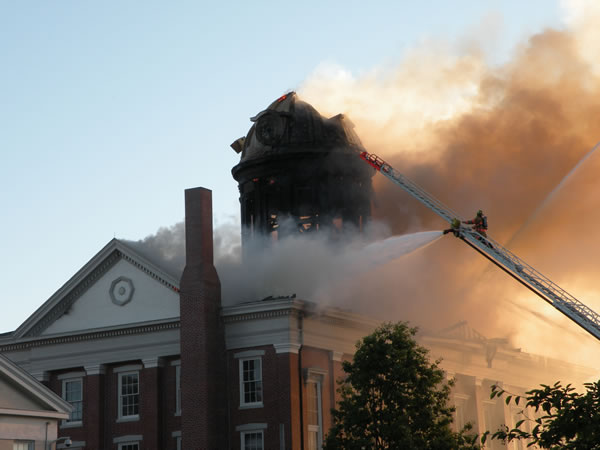As the sun on a clear blue sky day was beginning to make its descent in the west, sirens blared and fire trucks rushed to the Jefferson County Courthouse in Madison, Indiana. The fire department received a frantic call reporting flames billowing from the cupola of the beautiful and historic building. The fire proved extremely difficult to extinguish because of the copper covering on the dome and cupola. As a result, the wood portion of the cupola and the entire roof was totally destroyed. The fire department estimated that they used about 1,000,000 gallons of water to extinguish the fire.

The courthouse was built in 1854-1855 and its interior was extensively damaged in a fire in February 1859. Additions and changes over time have dramatically altered the building. In the 1950s its interior was gutted and a third floor was added to the original structure, which consisted of a basement, a main floor and a second floor. In the remodeling process concrete panels were placed between the exterior walls and the interior walls that formed the central hallway. These panels served as the base for the flooring on the third floor. When firefighters extinguished the flames, the water from their hoses ran between the panels and tended to flow into the central hallway. As a result, water damage to the first and second floors was somewhat limited.
John Newman and Tom Jones from State Court Administration visited the courthouse after the fire and reported seeing only standing puddles in the basement storage area, but that three to four inches of water were in the basement immediately after the fire. The Jefferson County Clerk’s office filed a disaster plan in 1993 with the Supreme Court’s Division of State Court Administration and reported that 112 file cabinets were housed in the basement. Clerk Kim Smith estimates that this number may have doubled since then.
The Jefferson County Superior Court and the Clerk’s office were both located on the second floor of the building. The courts’ server was located in the offices of the Superior Court.
The majority of current civil and criminal case files were in the clerk’s office. Many file cabinets and order books appeared to be dry, but records on counters and on desks were soaked.
Records located on the third floor included evidence from cases, confidential juvenile, probate and guardianship records, and active files from the Jefferson Circuit Court. The third floor ceiling and roof were completely destroyed. The full extent of the damage is under investigation and not yet determined.
The disaster recovery plan for court records had two main objectives: 1) provide continuity in the judicial functions by identifying and salvaging those current records that required immediate judicial review; and 2) provide a strategy to save and restore all valuable judicial records.
Lee Capatine, President of Art Recovery Technologies, is assisting in the recovery efforts. A lot of work remains to be done. And although there was costly and permanent physical damage done to this beautiful and historic building in southern Indiana, no one was injured and no lives were lost.